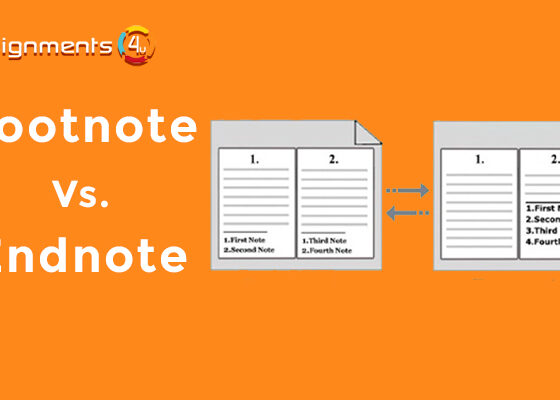Differences Between Endnotes & Footnotes
While attempting academic writing, be it an assignment or a dissertation, this goes beyond academic writing—to be honest, every choice is a make-or-break one. One such alternative is that of using either endnotes or footnotes. Both endnotes and footnotes are integral parts of academic writing, and students are expected to familiarize themselves with them. It is so because whenever you are using an idea that is not yours, either partially or entirely, you will have to mention where you acquired the opinion or the findings. But they should be aware of what is the difference between an endnote and a footnote.
It is called the source. If these sources are not mentioned, there is a high chance that your academic work will be regarded as plagiarized. The systematic way of arranging these sources, either citing them or adding additional details, is done through either endnotes or footnotes.
Therefore, before you can choose, you will have to understand what endnotes and footnotes are and what the choice entails. You must have noticed that you would find small numbers printed as a superscript on certain words, phrases, or sentences in academic texts. These numbers represent the endnotes and the footnotes. Here, we explain the differences between footnotes and endnotes.
Definition of Endnotes and Footnotes
As suggested by its name, an endnote can be found at the end of a section of text in the form of a note. It will contain sources for the information used in the text. They are used, primarily, to make citations of the titles of the sources used and their authors. These citations have to be arranged in chronological order.
The order, furthermore, will be informed by the referencing system used, be it MLA, APA, or otherwise. These citations are also denoted by symbols such as the asterisk.
You May Also Like: Know About In-Text Citation
As its name indicates, a footnote can be found at the bottom of the page instead of at the end of the text. Footnotes will be on almost all pages of the text or immediately at the bottom of the page where references are made. Researchers find it important to learn the differences between endnotes and footnotes in research.
Footnotes, also known as endnotes, are used to cite relevant sources and provide additional information about a particular part of the page’s text, which means that they are used to simplify the text above or add more details to it. Footnotes are also represented by a number or a symbol present at the superscript of the word or sentence. What is the purpose of footnotes and endnotes?
What are the key differences between endnotes and footnotes?

While there are not many differences between the endnotes and the footnotes, the differences are marked as they go beyond the question of placement, and their suitability should be considered for one’s specific needs before making a decision. These differences will give you clarity and help you make a well-informed decision:
- A footnote is a note whose purpose is to give extraneous information, and its focus is only on a particular part of the text. However, when it comes to the endnote, its sole purpose is to give credit or make citations, be it an essay or a book.
- Footnotes should go in the page’s footer, and endnotes should go at the end of the document without fail.
- Footnotes can be seen as an abridged extension of the information in the text. As opposed, the endnotes give more details about the external sources used in the writing of the text.
- Consequently, footnotes affect the page’s layout, and endnotes do not.
- Footnotes can be easy to locate, and readers can find them quickly at the end of the page. However, using too many footnotes can distract the reader and clutter the page. Similarly, even though endnotes are located in a separate section of the text, readers could find referring to another area often very distracting.
- One of the reasons for the distractions is that adding too much information will dominate the page. While readers can look at the ideas directly, the possibility of distracting them is a significant disadvantage. In the case of an endnote, every supplementary piece of information is placed in a separate section for convenience. Still, readers will have to remember the chapter numbers and page numbers to get to the correct endnote.
- It is easier to add footnotes, and they can be added automatically when the printing of the pages is done, but endnotes do not always get so much ease; they could have them attached with negative connotations.
- In academic circles, footnotes have been increasingly labelled as outdated, and endnotes are often preferred due to the modern technology of word processing programs. However, subjects like law and history continue to prefer footnotes.
- In the footnotes, the information has to be separated by commas. In contrast, in the endnotes, the information, like the author’s name and the source’s title, must be separated by periods.
- In the footnotes, the author’s first name comes first, while in the endnotes, the author’s last name has to be listed first. Go through some footnote and endnote examples to learn exactly.
Conclusion: Differences Between Endnotes & Footnotes
Footnotes and endnotes are an essential part of academic writing, for they help writers provide relevant information without causing any disruption in the reading. Therefore, to gain more clarity about academic content, avail yourself of the expertise of reputed agencies like ours to learn more about such special content solutions. The important fact about them is that these endnotes and footnotes need to be accompanied by a symbol or a number. They have to be organized in the manner suggested by the referencing system prescribed in the guidelines of the academic project. It would help if you were careful about what information you put in the footnotes or the endnotes. A critical analysis should be done to determine if the supplementary information is not spoiling the narrative flow of your academic writing.
Furthermore, with these ten key differences, as discussed above, you are all set to determine which kind of referencing is ideal for your specific needs if the decision is left to you to decide the specifics of your academic writing that you attempt. You can also explore the Difference Between Endnotes and Footnotes pdf to get more information on that.
Some related posts:












